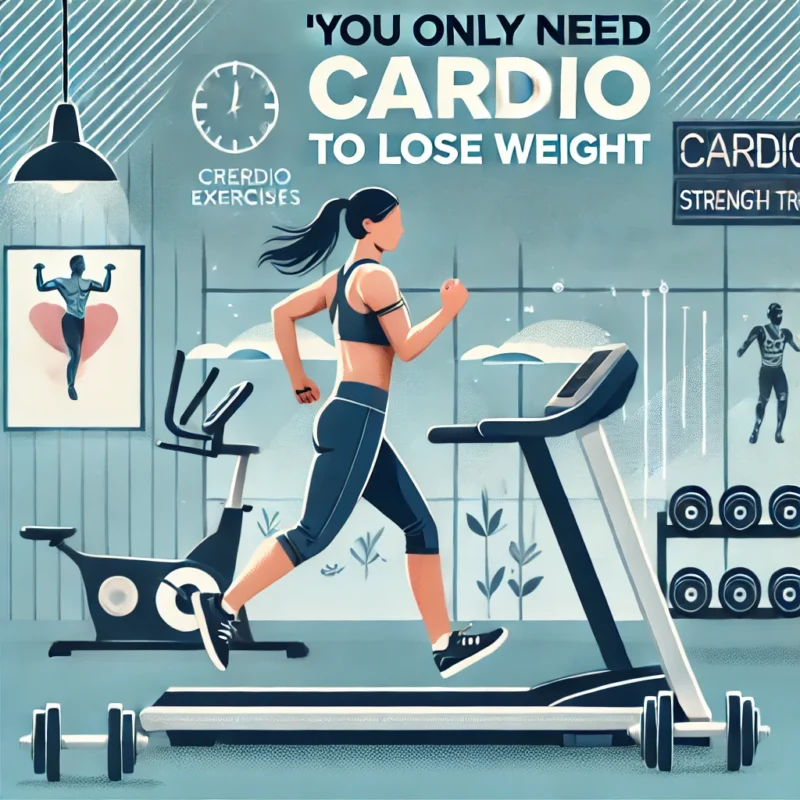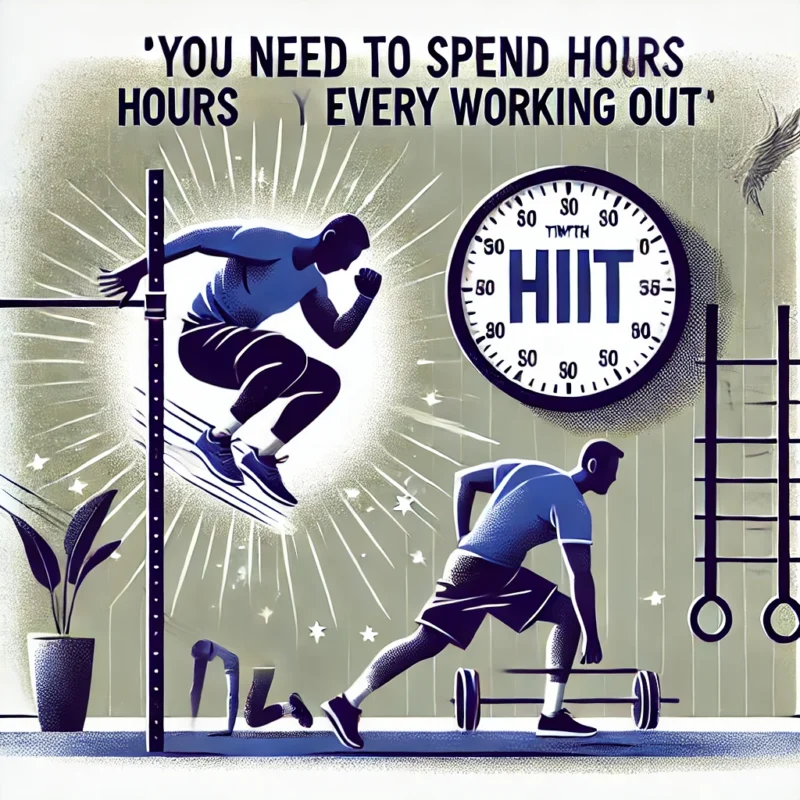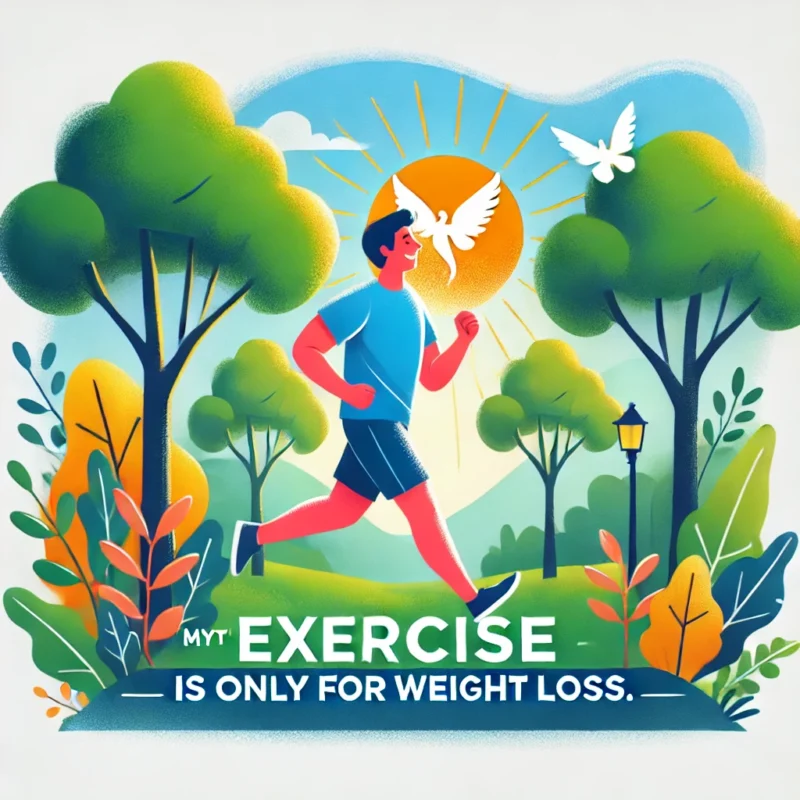In the world of fitness, especially for beginners, there is an overwhelming amount of information that can be confusing. Some advice may sound reasonable but is based on inaccurate myths. This not only hinders the achievement of desired results but can also lead to injuries or negative impacts on health. This article delves into the five most common myths and provides accurate information based on science and real-world experience.
Table of Contents
Myth 1: You Only Need Cardio to Lose Weight

Myth Analysis
- Many people believe that cardio (such as running, cycling, swimming) is the sole method to burn calories and lose weight.
- This belief stems from the high intensity associated with cardio exercises, making it easy to measure energy expenditure through workout devices.
Reality
- While cardio helps burn calories, it is not the only or best method for weight loss.
- Strength training (weight training) plays a crucial role in building muscle, boosting metabolism, and burning calories even at rest.
- Studies have shown that individuals who incorporate strength training have lower body fat percentages and increased muscle mass compared to those who only do cardio.
Advice
- Integrate both cardio and strength training into your workout program to achieve optimal results.
- Ensure a balanced and healthy diet to support your weight loss goals. Nutrition plays a pivotal role in weight management, complementing exercise for the best outcomes.
Supporting Scientific Research
- Multiple studies highlight the superior effectiveness of combining strength training with cardio for fat loss and muscle gain.
Additional Tips
- Consider varying your cardio exercises to prevent boredom and maintain motivation. Try incorporating activities like rowing, jump rope, or dance-based workouts.
- Schedule regular strength training sessions focusing on different muscle groups to ensure balanced muscle development and prevent overuse injuries.
Workout Example
- Create a weekly workout plan that includes three days of cardio and two days of strength training. For example:
- Monday: 30 minutes of running
- Tuesday: Upper body strength training
- Wednesday: 30 minutes of cycling
- Thursday: Lower body strength training
- Friday: 30 minutes of swimming
Myth 2: Lifting Weights Will Make You Bulky

Myth Analysis
- Many people, particularly women, fear that lifting heavy weights will make them muscular and bulky.
- The images of professional bodybuilders often lead to the misconception that weight training will result in a similar physique.
Reality
- Achieving the level of musculature seen in bodybuilders requires extremely strict training and nutrition regimens, along with specialized dietary supplements.
- Training with light to moderate weights not only helps you gain strength but also tones your body, making it firm and well-proportioned. Light weight exercises can also improve cardiovascular health, flexibility, and endurance.
Advice
- Do not be afraid of lifting weights; it will help you achieve a healthy and toned body. Remember, gaining excessive muscle mass is very difficult and requires much more effort than you might think.
- Start with lighter weights and gradually increase as you feel comfortable and confident. This will not only help you avoid injuries but also allow your body to gradually adapt to the training intensity.
Supporting Scientific Research
- Studies have shown that moderate intensity weight training improves overall health and does not lead to excessive muscle gain in women.
Additional Tips
- Focus on compound exercises that work multiple muscle groups simultaneously, such as squats, deadlifts, and bench presses.
- Incorporate resistance bands or bodyweight exercises for variety and to challenge your muscles in different ways.
Workout Example
- A balanced strength training routine might include:
- Squats with dumbbells
- Push-ups or bench presses
- Deadlifts
- Rows with resistance bands
- Planks for core strength
Myth 3: You Need to Spend Hours Every Day Working Out

Myth Analysis
- Some people believe that to achieve a fit and healthy body, they need to spend several hours a day in the gym.
- This misconception can lead to feelings of discouragement and fatigue among beginners, causing them to easily abandon their workout routine.
Reality
- The effectiveness of your workouts does not depend on the time spent but on the quality and consistency of your efforts.
- Short, high-intensity workouts (like HIIT – High-Intensity Interval Training) can yield better results than long, leisurely sessions. Research indicates that just 20 minutes of HIIT a day can effectively improve cardiovascular health and reduce body fat.
Advice
- Focus on planning short but effective workouts, such as HIIT sessions.
- Maintain a consistent workout schedule and ensure you get enough rest to recover. Rest and recovery are just as important as the workouts themselves, helping your body regenerate and prepare for the next sessions.
Supporting Scientific Research
- Research has proven that short HIIT workouts can offer the same, if not greater, health benefits compared to traditional long-duration workouts.
Additional Tips
- Incorporate a variety of HIIT workouts to keep things interesting. Examples include sprint intervals, circuit training, and bodyweight exercises like burpees and jumping jacks.
- Schedule rest days or active recovery days to allow your muscles to recover and prevent burnout.
Workout Example
- A simple HIIT workout plan could include:
- 30 seconds of sprinting, followed by 30 seconds of walking, repeated 10 times.
- Circuit of 1 minute each of push-ups, squats, burpees, and jumping jacks, repeated 3 times with short breaks in between.
Myth 4: You Must Follow a Strict Diet to See Results

Myth Analysis
- Some people believe that to lose weight or maintain a good physique, they must adhere to a strict and harsh diet.
- Diets like keto, paleo, or low-carb are often considered the “key” to weight loss and maintaining a good body.
Reality
- Strict diets can lead to nutrient deficiencies and are not sustainable in the long term. Cutting a large amount of calories or completely eliminating a food group can deprive your body of essential nutrients.
- A balanced, nutrient-rich diet combined with calorie control is a more sustainable solution. Studies have shown that maintaining a varied and balanced diet helps in long-term health and effective weight management better than strict diets.
Advice
- Instead of following harsh diets, build a healthy and balanced eating plan. Focus on consuming natural, nutrient-rich foods like green vegetables, fruits, lean proteins, fish, legumes, and healthy fats from olive oil, nuts, and avocados.
- Control your portion sizes and pay attention to your body’s satiety signals to maintain a natural and sustainable weight.
Supporting Scientific Research
- Research has shown that a balanced, nutrient-rich diet and moderation are more effective for maintaining health and weight compared to strict diets.
Additional Tips
- Include a variety of foods in your diet to ensure you get a wide range of nutrients.
- Plan your meals and snacks ahead of time to avoid unhealthy food choices.
Diet Example
- A balanced meal plan might include:
- Breakfast: Oatmeal with berries and nuts
- Lunch: Grilled chicken salad with mixed greens, tomatoes, and avocado
- Dinner: Baked salmon with quinoa and steamed vegetables
- Snacks: Greek yogurt, fruit, or a handful of nuts
Myth 5: Exercise Is Only for Weight Loss

Myth Analysis
- Many people think that the only purpose of exercising is to lose weight or stay in shape. This mindset often leads to a loss of motivation when they don’t see immediate weight loss results.
- They tend to overlook other benefits of exercising like improving mental health, enhancing strength, and increasing flexibility.
Reality
- Exercise not only helps in weight loss but also brings numerous other benefits such as improving cardiovascular health, increasing strength and flexibility, reducing stress, and enhancing mood. Studies have shown that regular exercise helps lower the risk of chronic diseases like diabetes, heart disease, and high blood pressure.
- Exercising also helps improve sleep quality, boost spirits, and enhance cognitive functions. Regular exercise can make you feel more fulfilled and happy in daily life.
Advice
- Find joy in exercising and see it as an integral part of your life. Instead of focusing solely on weight loss, set other goals like improving strength, enhancing flexibility, or simply feeling healthier.
- Remember, all physical activities have their own benefits, from walking, running, to yoga or even dancing. The important thing is to find an activity you love and can maintain in the long term.
Supporting Scientific Research
- Numerous studies have shown that regular exercise not only helps with weight loss but also improves mental health, flexibility, strength, and reduces the risk of chronic diseases.
Additional Tips
- Try different types of physical activities to find what you enjoy most. This could include hiking, swimming, or joining a sports team.
- Set achievable fitness goals and track your progress to stay motivated.
Workout Example
- A varied weekly workout plan could include:
- Monday: Yoga for flexibility and relaxation
- Tuesday: Strength training for overall body conditioning
- Wednesday: Jogging or brisk walking for cardiovascular health
- Thursday: High-Intensity Interval Training (HIIT) for efficient calorie burn
- Friday: Swimming or cycling for low-impact cardio
- Saturday: Dance class or group fitness class for fun and social interaction
- Sunday: Rest or light stretching for recovery
Conclusion
Fitness myths can lead to ineffective and even harmful exercise habits. Understanding and debunking these myths is the first step to starting a correct and effective fitness journey. Remember, there is no one-size-fits-all formula, the key is to find what works best for you.
Additional Information
Supporting Scientific Research
Cite scientific studies that reinforce the points made in each myth section. This provides credibility and helps readers understand the scientific basis behind the information.
- Myth 1: You Only Need Cardio to Lose Weight
- A study published in the Journal of Applied Physiology found that combining resistance training with aerobic exercise resulted in greater improvements in body composition compared to aerobic exercise alone.
- Another research published in the International Journal of Obesity showed that participants who engaged in a combination of cardio and resistance training lost more fat mass and gained more muscle mass than those who only did cardio exercises.
- Myth 2: Lifting Weights Will Make You Bulky
- A study in the Journal of Strength and Conditioning Research indicated that women who participated in resistance training programs gained significant strength and muscle tone without a corresponding increase in muscle bulk.
- Research from the Journal of Applied Physiology highlighted that moderate resistance training leads to muscle endurance and strength gains without excessive muscle hypertrophy, especially in women.
- Myth 3: You Need to Spend Hours Every Day Working Out
- A study published in the journal PLOS ONE found that short, high-intensity workouts such as HIIT are just as effective, if not more so, than longer traditional workouts in improving cardiovascular health and reducing body fat.
- Research in the American Journal of Physiology stated that as little as 20 minutes of high-intensity interval training three times a week can improve aerobic capacity and body composition significantly.
- Myth 4: You Must Follow a Strict Diet to See Results
- Research published in the New England Journal of Medicine highlighted that moderate, sustainable dietary changes combined with regular exercise are more effective for long-term weight management than strict, restrictive diets.
- A study in the Journal of the American Medical Association found that a balanced diet rich in nutrients, combined with portion control, leads to better health outcomes and sustainable weight loss.
- Myth 5: Exercise Is Only for Weight Loss
- A study in the American Journal of Psychiatry reported that regular physical activity significantly reduces the risk of depression, demonstrating the mental health benefits of exercise beyond weight loss.
- Research in the British Journal of Sports Medicine found that consistent exercise improves cognitive function and reduces the risk of chronic diseases, emphasizing the holistic benefits of regular physical activity.
Mental Health Benefits of Exercise
Exercising regularly offers numerous mental health benefits, which often go unnoticed by those solely focused on physical outcomes. It is important to recognize that exercise can significantly impact mental well-being.
- Reduction in Stress and Anxiety
- Physical activity stimulates the production of endorphins, which are chemicals in the brain that act as natural painkillers and mood elevators. This can help reduce stress and alleviate symptoms of anxiety.
- Studies have shown that regular exercise can decrease the levels of cortisol, a stress hormone, thereby promoting relaxation and reducing feelings of stress.
- Improvement in Mood and Reduction in Depression
- Engaging in regular physical activity has been shown to reduce the symptoms of depression. Exercise enhances the secretion of neurotransmitters such as serotonin and dopamine, which are associated with improved mood and feelings of happiness.
- Research indicates that people who exercise regularly are less likely to experience major depressive episodes.
- Enhanced Cognitive Function
- Exercise promotes neurogenesis, the formation of new neurons in the brain, which can help improve cognitive functions like memory, attention, and learning.
- Studies have shown that regular physical activity is linked to improved performance on tasks that require executive functions, such as planning, problem-solving, and multitasking.
- Better Sleep Quality
- Regular exercise has been found to improve sleep quality, helping individuals fall asleep faster and enjoy deeper, more restorative sleep.
- Improved sleep patterns are associated with better overall health and well-being, as good sleep is crucial for physical recovery and mental clarity.
- Increase in Self-Esteem and Confidence
- Achieving fitness goals and noticing physical improvements can boost self-esteem and confidence.
- Exercise provides a sense of accomplishment and can improve body image, which contributes to overall positive self-worth.
Suggested Workout Programs
Providing structured workout programs can help beginners create effective and balanced routines. Below are examples of workout programs combining cardio, strength training, and flexibility exercises.
- Beginner Program: Full-Body Circuit Training
- Warm-Up (5-10 minutes):
- Dynamic stretches (leg swings, arm circles)
- Light cardio (jogging in place, jumping jacks)
- Circuit (3 rounds, 45 seconds each exercise, 15 seconds rest):
- Squats
- Push-Ups (modified if necessary)
- Bent-Over Rows (using dumbbells or resistance bands)
- Plank
- Glute Bridges
- Cool-Down (5-10 minutes):
- Static stretching (hamstring stretch, quadriceps stretch, shoulder stretch)
- Warm-Up (5-10 minutes):
- Intermediate Program: Cardio and Strength Split
- Day 1: Cardio
- 30 minutes of running or cycling
- 15 minutes of HIIT (sprint intervals)
- Day 2: Upper Body Strength
- Bench Press or Push-Ups
- Dumbbell Rows
- Shoulder Press
- Bicep Curls
- Tricep Dips
- Day 3: Lower Body Strength
- Squats
- Lunges
- Deadlifts
- Calf Raises
- Leg Press
- Day 4: Cardio
- 45 minutes of moderate-intensity cardio (elliptical, rowing, brisk walking)
- Day 5: Full-Body Strength
- Combination of upper and lower body exercises
- Day 6: Flexibility and Recovery
- Yoga or Pilates
- Light stretching and foam rolling
- Day 7: Rest or Light Activity
- Gentle walk or stretching
- Day 1: Cardio
- Advanced Program: High-Intensity Training
- Warm-Up (10 minutes):
- Jump Rope
- Dynamic stretches
- Workout (4 rounds, 1 minute each exercise, 15 seconds rest):
- Burpees
- Kettlebell Swings
- Pull-Ups
- Box Jumps
- Medicine Ball Slams
- Cool-Down (10 minutes):
- Light jogging
- Static stretching
- Warm-Up (10 minutes):
Suggested Nutrition Plans
Balanced nutrition is crucial for supporting fitness goals. Here are examples of daily meal plans for different dietary needs.
- Balanced Diet Plan
- Breakfast:
- Greek yogurt with honey, berries, and granola
- Snack:
- Apple slices with almond butter
- Lunch:
- Quinoa salad with grilled chicken, avocado, cherry tomatoes, and a lemon vinaigrette
- Snack:
- Carrot sticks with hummus
- Dinner:
- Grilled salmon with sweet potato mash and steamed broccoli
- Snack:
- Cottage cheese with pineapple chunks
- Breakfast:
- Low-Carb Diet Plan
- Breakfast:
- Scrambled eggs with spinach and cheese
- Snack:
- Handful of mixed nuts
- Lunch:
- Lettuce wraps with turkey, avocado, and cucumber
- Snack:
- Sliced bell peppers with guacamole
- Dinner:
- Grilled chicken with cauliflower rice and sautéed asparagus
- Snack:
- Greek yogurt with chia seeds
- Breakfast:
- Vegetarian Diet Plan
- Breakfast:
- Smoothie bowl with banana, berries, spinach, and almond milk, topped with granola
- Snack:
- Sliced avocado on whole grain toast
- Lunch:
- Lentil and vegetable soup with a side of mixed greens salad
- Snack:
- Roasted chickpeas
- Dinner:
- Stir-fried tofu with mixed vegetables and brown rice
- Snack:
- Cottage cheese with sliced peaches
- Breakfast:
Workout Support Tools
Leveraging technology and tools can enhance your fitness journey. Here are some recommended tools and gadgets:
- Fitness Apps:
- MyFitnessPal: A comprehensive app for tracking calories, macro nutrients, and exercise.
- Nike Training Club: Offers a wide range of workouts, from strength training to yoga, with video guidance.
- Headspace: Provides guided meditations to complement your physical fitness with mental health benefits.
- Wearable Devices:
- Fitbit: Tracks daily activity, heart rate, and sleep patterns, helping you stay on top of your fitness goals.
- Apple Watch: Offers fitness tracking, heart rate monitoring, and integrates with various fitness apps.
- Garmin Forerunner: Ideal for runners, it tracks distance, pace, and heart rate, providing detailed performance analytics.
- Home Workout Equipment:
- Resistance Bands: Versatile and portable, they are great for strength training and stretching.
- Dumbbells: Essential for strength training, available in various weights to suit different fitness levels.
- Yoga Mat: Provides comfort and support for floor exercises and yoga practices.
Final Thoughts
Anyone can start their fitness journey effectively and safely with the right knowledge and by avoiding common myths. Always listen to your body, stay motivated, and find joy in exercising. Wishing you success on your path to achieving fitness and health!
